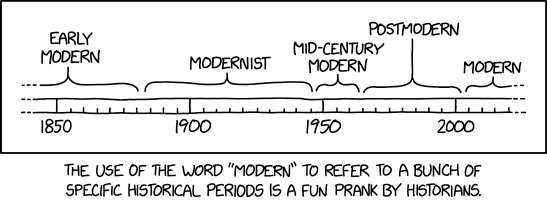#3089: Modern
Permalink
Transcript
[At the bottom of the panel a timeline is shown. It consist of two lines, one a bit above the other, and they are both open in both ends with two dots continuing both before and after the solid lines. There are ticks along the bottom of the two lines, and every tenth tick is longer and connects with the top line. There are four of these which are all labeled with a year written under the bottom line. The first tick is one of those connecting to the upper line, but after the last of those there are four more small ticks.]
1850 1900 1950 2000
[Above the timeline there are five brackets indicating segments on the time line, each of them covering a segment from the previous to the next, and the first and last are open with a few dots indicating hey continue before or after the time line. Each of them has a sharp pivot in the middle of the bracket pointing up to a label for that period of time. In the fourth case the pivot is very high to make room for the text, as it would else conflict with the previous text. The entire timeline is thus divided into these five segments. The length of each bracket varies a lot, with the middle of the five by far the shortest. But the two at the ends are open and the entire length of these cannot be determined. The labels and the time period their brackets cover:]
[Before 1850 until 1880:]
Early Modern
[1880 until 1945:]
Modernist
[1945 until 1965:]
Mid-century modern
[1965 until 2000:]
Postmodern
[2000 until past 2020:]
Modern
[Caption below the panel:]
The use of the word "modern" to refer to a bunch of specific historical periods is a fun prank by historians.
(Sourced from explainxkcd.com)
Title text:Scholars are still debating whether the current period is post-postmodern or neo-contemporary.